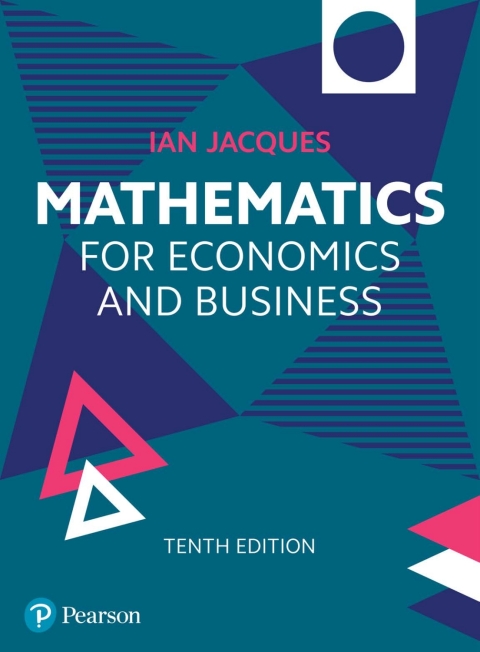Description
Efnisyfirlit
- Half Title
- Title Page
- Copyright Page
- Contents
- Preface
- INTRODUCTION: Getting Started
- Notes for students: how to use this text
- Tour of textbook features
- Chapter 1 Linear Equations
- 1.1 Introduction to algebra
- 1.1.1 Negative numbers
- 1.1.2 Expressions
- 1.1.3 Brackets
- Key Terms
- Exercise 1.1
- Exercise 1.1*
- 1.2 Further algebra
- 1.2.1 Fractions
- 1.2.2 Equations
- 1.2.3 Inequalities
- Key Terms
- Exercise 1.2
- Exercise 1.2*
- 1.3 Graphs of linear equations
- Key Terms
- Exercise 1.3
- Exercise 1.3*
- 1.4 Algebraic solution of simultaneous linear equations
- Key Term
- Exercise 1.4
- Exercise 1.4*
- 1.5 Supply and demand analysis
- Key Terms
- Exercise 1.5
- Exercise 1.5*
- 1.6 Transposition of formulae
- Key Terms
- Exercise 1.6
- Exercise 1.6*
- 1.7 National income determination
- Key Terms
- Exercise 1.7
- Exercise 1.7*
- Case study 1
- Formal mathematics
- Multiple-choice questions
- Examination questions
- Chapter 2 Non-linear Equations
- 2.1 Quadratic functions
- Key Terms
- Exercise 2.1
- Exercise 2.1*
- 2.2 Revenue, cost and profit
- Key Terms
- Exercise 2.2
- Exercise 2.2*
- 2.3 Indices and logarithms
- 2.3.1 Index notation
- 2.3.2 Rules of indices
- 2.3.3 Logarithms
- 2.3.4 Summary
- Key Terms
- Exercise 2.3
- Exercise 2.3*
- 2.4 The exponential and natural logarithm functions
- Key Terms
- Exercise 2.4
- Exercise 2.4*
- Case study 2
- Formal mathematics
- Multiple-choice questions
- Examination questions
- Chapter 3 Mathematics of Finance
- 3.1 Percentages
- 3.1.1 Index numbers
- 3.1.2 Inflation
- Key Terms
- Exercise 3.1
- Exercise 3.1*
- 3.2 Compound interest
- Key Terms
- Exercise 3.2
- Exercise 3.2*
- 3.3 Geometric series
- Key Terms
- Exercise 3.3
- Exercise 3.3*
- 3.4 Investment appraisal
- Key Terms
- Exercise 3.4
- Exercise 3.4*
- Case study 3
- Formal mathematics
- Multiple-choice questions
- Examination questions
- Chapter 4 Differentiation
- 4.1 The derivative of a function
- Key Terms
- Exercise 4.1
- Exercise 4.1*
- 4.2 Rules of differentiation
- Rule 1 The constant rule
- Rule 2 The sum rule
- Rule 3 The difference rule
- Key Terms
- Exercise 4.2
- Exercise 4.2*
- 4.3 Marginal functions
- 4.3.1 Revenue and cost
- 4.3.2 Production
- 4.3.3 Consumption and savings
- Key Terms
- Exercise 4.3
- Exercise 4.3*
- 4.4 Further rules of differentiation
- Rule 4 The chain rule
- Rule 5 The product rule
- Rule 6 The quotient rule
- Exercise 4.4
- Exercise 4.4*
- 4.5 Elasticity
- Key Terms
- Exercise 4.5
- Exercise 4.5*
- 4.6 Optimisation of economic functions
- Key Terms
- Exercise 4.6
- Exercise 4.6*
- 4.7 Further optimisation of economic functions
- Key Term
- Exercise 4.7*
- 4.8 The derivative of the exponential and natural logarithm functions
- Exercise 4.8
- Exercise 4.8*
- Case study 4
- Formal mathematics
- Multiple-choice questions
- Examination questions
- Chapter 5 Partial Differentiation
- 5.1 Functions of several variables
- Key Terms
- Exercise 5.1
- Exercise 5.1*
- 5.2 Partial elasticity and marginal functions
- 5.2.1 Elasticity of demand
- 5.2.2 Utility
- 5.2.3 Production
- Key Terms
- Exercise 5.2
- Exercise 5.2*
- 5.3 Comparative statics
- Key Terms
- Exercise 5.3*
- 5.4 Unconstrained optimisation
- Key Terms
- Exercise 5.4
- Exercise 5.4*
- 5.5 Constrained optimisation
- Key Terms
- Exercise 5.5
- Exercise 5.5*
- 5.6 Lagrange multipliers
- Key Terms
- Exercise 5.6
- Exercise 5.6*
- Case study 5
- Formal mathematics
- Multiple-choice questions
- Examination questions
- Chapter 6 Integration
- 6.1 Indefinite integration
- Key Terms
- Exercise 6.1
- Exercise 6.1*
- 6.2 Definite integration
- 6.2.1 Consumer’s surplus
- 6.2.2 Producer’s surplus
- 6.2.3 Investment flow
- 6.2.4 Discounting
- 6.2.5 Income inequality
- Key Terms
- Exercise 6.2
- Exercise 6.2*
- Case study 6
- Formal mathematics
- Multiple-choice questions
- Examination questions
- Chapter 7 Matrices
- 7.1 Basic matrix operations
- 7.1.1 Transposition
- 7.1.2 Addition and subtraction
- 7.1.3 Scalar multiplication
- 7.1.4 Matrix multiplication
- 7.1.5 Summary
- Key Terms
- Exercise 7.1
- Exercise 7.1*
- 7.2 Matrix inversion
- Key Terms
- Exercise 7.2
- Exercise 7.2*
- 7.3 Cramer’s rule
- Key Term
- Exercise 7.3
- Exercise 7.3*
- Case study 7
- Formal mathematics
- Multiple-choice questions
- Examination questions
- Chapter 8 Linear Programming
- 8.1 Graphical solution of linear programming problems
- Key Terms
- Exercise 8.1
- Exercise 8.1*
- 8.2 Applications of linear programming
- Key Terms
- Exercise 8.2
- Exercise 8.2*
- Case study 8
- Formal mathematics
- Multiple-choice questions
- Examination questions
- Chapter 9 Dynamics
- 9.1 Difference equations
- 9.1.1 National income determination
- 9.1.2 Supply and demand analysis
- Key Terms
- Exercise 9.1
- Exercise 9.1*
- 9.2 Differential equations
- 9.2.1 National income determination
- 9.2.2 Supply and demand analysis
- Key Terms
- Exercise 9.2
- Exercise 9.2*
- Case study 9
- Formal mathematics
- Multiple-choice questions
- Examination questions
- Answers to Problems
- Chapter 1
- Chapter 2
- Chapter 3
- Chapter 4
- Chapter 5
- Chapter 6
- Chapter 7
- Chapter 8
- Chapter 9
- Glossary
- Index
- Back Cover





